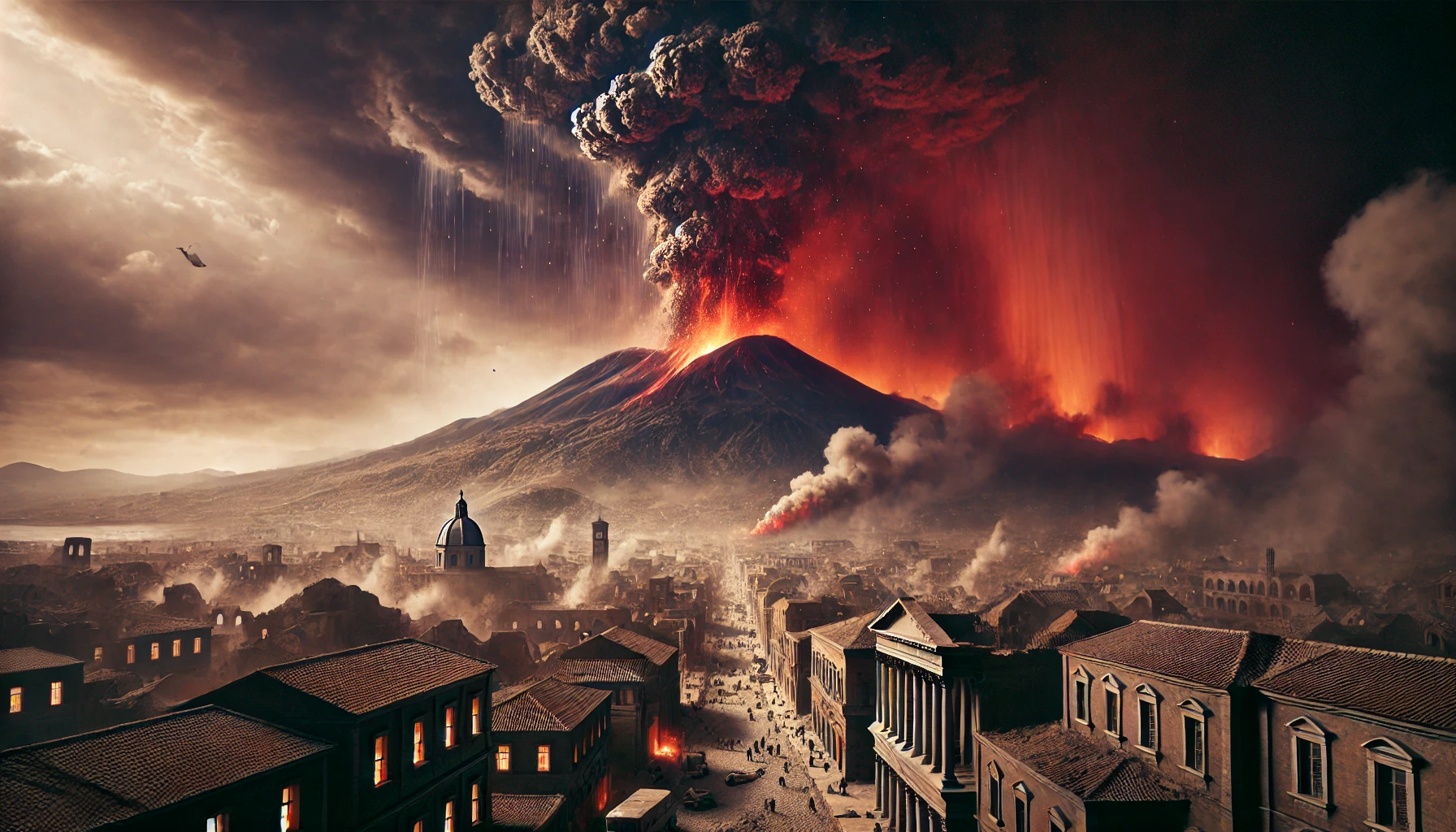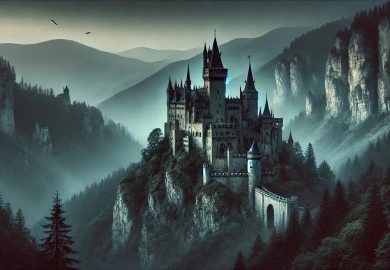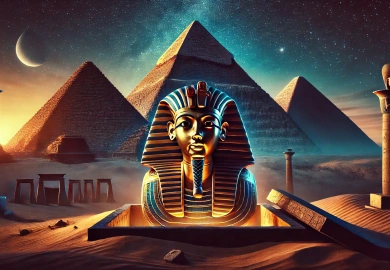
The Fall of Pompeii remains one of history’s most astonishing and tragic events. On the fateful day of August 24, AD 79, Mount Vesuvius erupted with devastating force, burying the once-thriving Roman city under layers of volcanic ash. This catastrophic event not only wiped out an entire civilization but also preserved Pompeii in a unique way, offering an unprecedented glimpse into ancient Roman life.
The destruction of Pompeii has fascinated historians, archaeologists, and visitors for centuries. It serves as a chilling reminder of nature’s power, yet it also unveils the richness of Roman culture through the artifacts and ruins left behind. Let’s explore how the fall of Pompeii unfolded, the aftermath, and what we’ve learned from this ancient tragedy.
The Sudden Eruption of Mount Vesuvius
In AD 79, the people of Pompeii were unaware that the dormant Mount Vesuvius looming over their city was an active volcano. For centuries, it had been a peaceful backdrop, and life thrived in this bustling Roman city. However, everything changed when the volcano erupted violently, sending a towering cloud of ash, smoke, and pumice into the sky.
The eruption lasted for nearly 24 hours, with a deadly mix of pyroclastic flows and superheated gases descending upon the city. The residents had little time to react; while some fled, many were caught in the deluge of volcanic debris. Streets filled with ash, rooftops collapsed, and bodies were buried in layers of pumice stone. What was once a thriving metropolis became a desolate wasteland in a matter of hours.
Despite its destructive force, the eruption’s aftermath provided a unique preservation of the city. Ash and debris covered Pompeii, freezing it in time. This natural entombment preserved everything from homes to everyday objects, giving modern archaeologists an unrivaled look into the daily life of ancient Romans.
Pompeii’s Archaeological Discovery: A City Unearthed
Centuries after Pompeii’s fall, the city remained hidden beneath the earth, forgotten until a series of archaeological excavations in the 18th century brought it back into the light. When the first explorers began unearthing Pompeii, they were astounded by what they found. The city, though destroyed, was preserved in extraordinary detail. From frescoes on walls to household items and even the bodies of its residents, Pompeii was like a time capsule of the Roman Empire.
The most remarkable discoveries included well-preserved villas, shops, and baths that reflected Roman society’s complexity. Beautiful frescoes depicting mythological scenes adorned the walls of homes, and intricate mosaics displayed the artistic skills of the era. The discovery of pottery, furniture, and everyday items provided invaluable insights into Roman culture and economy.
But perhaps the most haunting discoveries were the preserved bodies, immortalized in the positions they held at the time of their deaths. Using a technique called plaster casting, archaeologists could capture the forms of these victims, offering a powerful reminder of the human cost of this tragedy. These plaster casts are now some of the most poignant exhibits in Pompeii, telling the story of a city caught off guard by nature’s fury.
Daily Life in Pompeii Before the Eruption
Before the devastating eruption, Pompeii was a thriving and bustling city, known for its vibrant economy and rich cultural life. Located near the Bay of Naples, Pompeii was an important center for trade, agriculture, and leisure. Its streets were lined with shops, bakeries, taverns, and temples, reflecting a bustling urban life. The people of Pompeii enjoyed public baths, theaters, and even a sophisticated water system that delivered fresh water to homes.
The city was also famous for its villas and gardens, where the wealthy elite of Pompeii resided. Many of these homes featured lavish decorations, including frescoes and mosaics, which highlighted the artistic talents of the time. The elite of Pompeii held grand feasts and social gatherings, reveling in the prosperity that the city enjoyed.
Religion played an essential role in Pompeii’s daily life. Temples dedicated to Roman gods and goddesses were scattered throughout the city. Public gatherings and festivals were common, providing citizens a chance to honor their deities and celebrate their good fortune. It is this everyday life that was forever preserved in the ruins of Pompeii, offering a remarkable snapshot of Roman society in AD 79.
The Preservation of Pompeii: A Window Into Ancient Roman Life
One of the most significant aspects of Pompeii’s fall is how well it has been preserved over the centuries. The layers of volcanic ash that buried the city acted as a protective shield, keeping structures, artifacts, and even food items intact for nearly two thousand years. This unique preservation allows modern historians and archaeologists to study ancient Roman life in extraordinary detail.
Walking through the ruins of Pompeii today, one can still see frescoes on walls, inscriptions etched into stone, and the remnants of Roman architecture. Public buildings like the amphitheater, the forum, and temples stand as silent witnesses to a once-thriving society. Pompeii’s well-preserved streets, complete with stepping stones and cart ruts, allow visitors to walk in the footsteps of ancient Romans, providing an immersive experience like no other.
Pompeii’s preservation has also revealed much about the diet and daily routines of its inhabitants. Archaeologists have uncovered carbonized loaves of bread, jars of preserved food, and even remnants of plants in the gardens. These findings offer a rare glimpse into what people ate and how they lived in the Roman Empire.
The legacy of Pompeii extends far beyond the ruins. It has become a symbol of human fragility in the face of nature’s power and a source of valuable knowledge about Roman civilization. Today, millions of visitors come to Pompeii each year to witness the incredible preservation of a city that time forgot, but nature remembered.
The tragic fall of Pompeii stands as a stark reminder of the unpredictable power of nature. The eruption of Mount Vesuvius destroyed a city, yet in doing so, it preserved an entire way of life for future generations to discover. The ruins of Pompeii offer an unparalleled glimpse into the Roman Empire’s daily life, architecture, and culture, making it one of the most important archaeological sites in the world.
Though the fall of Pompeii was a devastating tragedy, the city’s preservation has given us a time machine, allowing us to walk through the streets of an ancient civilization and witness history firsthand. Today, Pompeii remains a UNESCO World Heritage site and continues to captivate and educate people from around the world.








